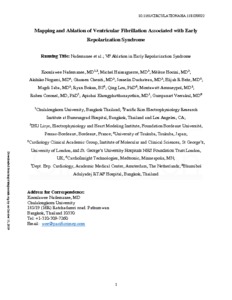Nademanee, K;
Haissaguerre, M;
Hocini, M;
Nogami, A;
Cheniti, G;
Duchateau, J;
Behr, ER;
Saba, M;
Bokan, R;
Lou, Q;
et al.
Nademanee, K; Haissaguerre, M; Hocini, M; Nogami, A; Cheniti, G; Duchateau, J; Behr, ER; Saba, M; Bokan, R; Lou, Q; Amnueypol, M; Coronel, R; Khongphatthanayothin, A; Veerakul, G
(2019)
Mapping and Ablation of Ventricular Fibrillation Associated with Early Repolarization Syndrome.
Circulation, 140 (18).
pp. 1477-1490.
ISSN 1524-4539
https://doi.org/10.1161/CIRCULATIONAHA.118.039022
SGUL Authors: Behr, Elijah Raphael
![[img]](https://openaccess.sgul.ac.uk/111277/1.hassmallThumbnailVersion/CIRCULATIONAHA.118.039022.pdf)  Preview |
|
PDF
Published Version
Available under License ["licenses_description_publisher" not defined].
Download (4MB)
| Preview
|
Abstract
Background: We conducted a multicenter study to evaluate mapping and ablation of ventricular fibrillation (VF) substrates or VF triggers in early repolarization syndromes (ERS) or J-wave syndrome (JWS). Methods: We studied 52 ERS patients (4 females; median age, 35 years) with recurrent VF episodes. Body-surface electrocardiographic imaging (ECGI) along with endocardial and epicardial electroanatomic mapping of both ventricles were performed during sinus rhythm and VF for localization of triggers, substrates, and drivers. Ablations were performed on:1) VF substrates defined as areas that had late depolarization abnormalities characterized by low voltage fractionated late potentials and 2) VF triggers. Results: Fifty-one of the 52 patients had detailed mapping which revealed two phenotypes: 1) Group 1 had late depolarization abnormalities predominantly at the right ventricular (RV) epicardium (n=40); and 2) Group 2 had no depolarization abnormalities (n=11). Group 1 can be subcategorized into 2 groups: Group 1A included 33 ERS patients with Brugada ECG pattern, and Group 1B included 7 ERS patients without Brugada ECG pattern. Late depolarization areas co-localize with VF driver areas. The anterior RV outflow tract (RVOT)/RV epicardium and the RV inferior epicardium are the major substrate sites for Group 1. The Purkinje network is the leading underlying VF trigger in Group 2 that had no substrates. Ablations were performed in 43 patients: 33 and 5 Group 1 patients had only VF substrate ablation and VF substrates plus VF trigger, respectively (mean 1.4 ± 0.6 sessions); 5 Group 2 patients and 1 without group classification had only Purkinje VF trigger ablation (mean 1.2 ± 0.4 sessions). Ablations were successful in reducing VF recurrences (p<0.0001). After follow-up of 31 ± 26 months, 39 (91%) had no VF recurrences. Conclusions: There are 2 phenotypes of ERS/JWS: 1) one with late depolarization abnormality as the underlying mechanism of high amplitude J-wave elevation that predominantly resides in the RVOT and RV inferolateral epicardium, serving as an excellent target for ablation; and 2) the other with pure ERS devoid of VF substrates, but with VF triggers that are associated with Purkinje sites. Ablation is effective in treating symptomatic ERS/JWS patients with frequent VF episodes.
| Item Type: |
Article
|
| Additional Information: |
This is a non-final version of an article published in final form in Nademanee, K; Haissaguerre, M; Hocini, M; Nogami, A; Cheniti, G; Duchateau, J; Behr, ER; Saba, M; Bokan, R; Lou, Q; et al. (2019) Mapping and Ablation of Ventricular Fibrillation Associated with Early Repolarization Syndrome. Circulation, 140 (18). pp. 1477-1490. |
| Keywords: |
Early Repolarization syndrome, J-wave syndrome, Cardiovascular System & Hematology, 1103 Clinical Sciences, 1102 Cardiovascular Medicine And Haematology, 1117 Public Health And Health Services |
| SGUL Research Institute / Research Centre: |
Academic Structure > Molecular and Clinical Sciences Research Institute (MCS) |
| Journal or Publication Title: |
Circulation |
| ISSN: |
1524-4539 |
| Language: |
eng |
| Dates: |
| Date | Event |
|---|
| 29 October 2019 | Published | | 23 September 2019 | Published Online | | 5 September 2019 | Accepted |
|
| Publisher License: |
Creative Commons: Attribution-Noncommercial-No Derivative Works 4.0 |
| Projects: |
|
| PubMed ID: |
31542949 |
 |
Go to PubMed abstract |
| URI: |
https://openaccess.sgul.ac.uk/id/eprint/111277 |
| Publisher's version: |
https://doi.org/10.1161/CIRCULATIONAHA.118.039022 |
Statistics
Item downloaded times since 11 Oct 2019.
Actions (login required)
 |
Edit Item |



